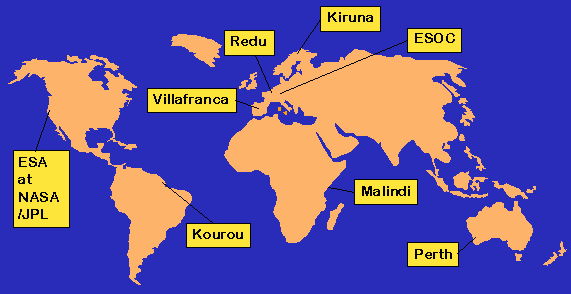

In the last twenty years VILSPA has supported many ESA and International Programs such as:
IUE(International Ultraviolet Explorer): Launched January
1978. Its mission was to provide a space observatory for ultraviolet spectrometry
of celestial objects.VILSPA hosted Centers for IUE spacecraft Control,
Science Operations, Data processing and Data Distribution.
At a Mission Elapsed Time of 18 years and 8 months, IUE was shut down
30 September 1996. This project ended last 28 February 1998 after completing
IUE Final Archive: a homogeneous database of 100,000+ images, from about
9,300 objects, taken over the course of the mission.
OTS-2 (Orbital Test satellite): Launched in 1978. De-orbited January 1991. This experimental project prepared the way for the ECS operational system making extensive propagation experiments by means of 8 small earth stations (one of them at VILSPA) and 30 small receive-only ones that measured beacon signals from the spacecraft. More than 45000 scheduled Ranging measurements were performed from VILSPA to OTS-2 and to its successors: ECS-1, ECS-2, ECS-4 and ECS-5.
GOES-1(Geostationary Operational Environmental Satellite):
It was one of the five geostationary meteorological satellites that composed
the GARP project (Global Atmospheric Research Program). It started 1 December
1978 and terminated 30 November 1979.
VILSPA mission was to command it every 30 minutes to scan the part
of the Earth where it was located (Indian Ocean).Visible and Infra-red
global images sent by GOES-1 were analog and digitally recorded 24 hours/day
and sent to SSEC (Wisconsin) for further analysis together with the images
supplied by the other satellites involved in this project.
MARECS (Maritime Communication Satellite): Two satellites
were launched. MARECS-A in December 1981 and MARECS-B2 in November 1984.
Their purpose was to develop a geostationary maritime communications system
whose services had characteristics similar to those of the fixed service
(with respect to quality, automatic operation etc.). It was the most effective
way of overcoming the drawbacks of radiotelephony. By that time 93% of
all messages to ships at sea were sent in Morse code and only 7% by radiotelephony!.
MARECS Spacon (located at Redu, Belgium) monitors the Telemetry and
send Commands and Ranging measurements requests to MARECS-B2 via Villafranca
C-Band Terminal.
MARECS-A was de-orbited 22 August 1996 due to a high degradation of
its solar array section.
EXOSAT (European X-Ray Observatory): Launched in 1982. Its scientific mission was to measure the position, structural features, spectral and temporal characteristics of cosmic X-ray sources. VILSPA was the Prime TT&C Station during the whole EXOSAT life. Spacecraft Control and Science Operations were at ESOC.
ISO (Infrared Space Observatory): It was launched on 17
November 1995. It carried out observations of astronomical objects in the
2.5 - 240 µm range of the spectrum. VILSPA hosted Centers for ISO
spacecraft Control, Science Operations, Data processing and Data Distribution.
ISO was switched off on May 16 at 14:00 h (CEST), thereby bringing
to a close its highly-successful in-orbit operations (ISO has successfully
made more than 26,000 observations of cool and hidden places in the Universe).
It is worthwhile to mention VILSPA contribution to other projects like GIOTTO, PROSAT, PRODAT, PROMAR and SOHO.
As part of the ESOC Station Network, VILSPA has given Telemetry, Command and Ranging support during the Early Orbit Phase period of many satellites like HIPPARCOS, MOP-1, MOP-2, MOP-3, OLYMPUS, ITALSAT, ERS-1, ERS-2, MTP and ITALSAT-F2.
TT&C back-up support of all these satellites was also given when
their Prime TT&C Station were down or during critical phases (spacecrafts
anomalies).
